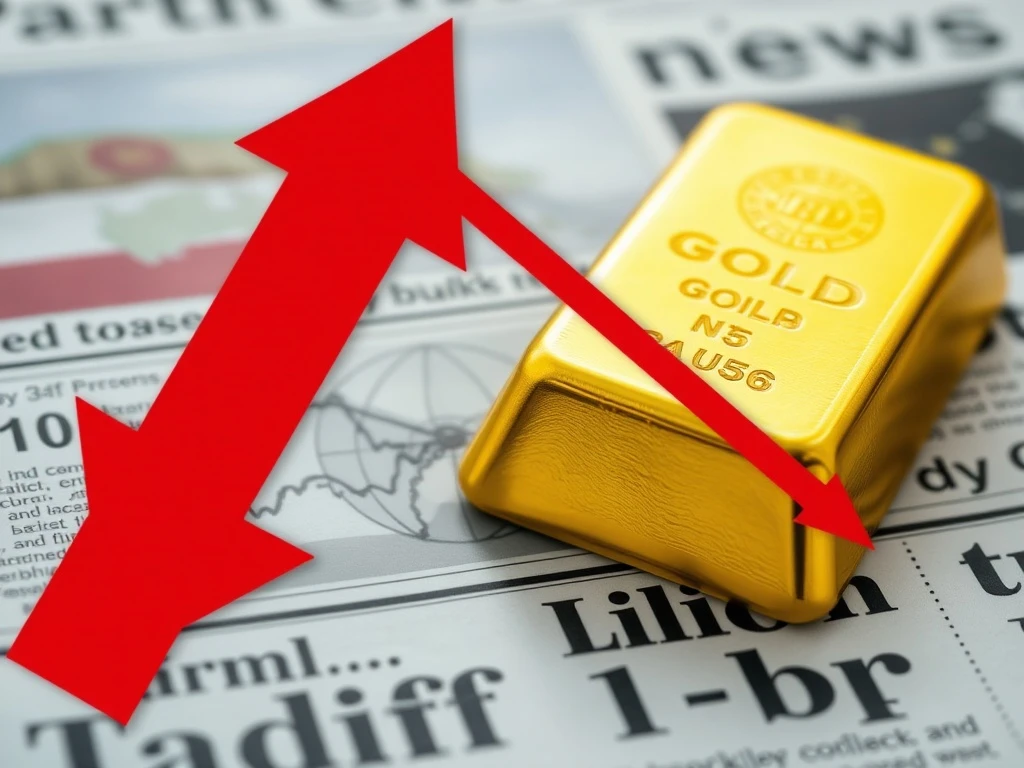The financial markets recently witnessed a significant **Gold Price Drop**, marking its largest daily decline in three months. This sharp movement came swiftly after unexpected news regarding tariff exemptions, directly impacting the precious metal’s traditional safe-haven appeal. For investors and market observers alike, understanding the forces behind such a sudden shift is crucial. This article delves into the specifics of this decline, examining the catalyst and broader market implications.
Understanding the Recent Gold Price Drop
Gold experienced a substantial decline in value, reflecting a notable shift in investor sentiment. On a specific trading day, the yellow metal saw its value fall considerably, marking its biggest daily percentage drop in approximately three months. This significant **Gold Price Drop** immediately captured market attention globally. Historically, gold often serves as a hedge against economic uncertainty and inflation. Therefore, a sudden fall prompts a deeper look into the underlying reasons.
Market participants often view gold as a stable asset during turbulent times. However, its price can react sharply to specific economic and political announcements. The recent downturn highlights gold’s sensitivity to shifts in global trade policy and investor confidence. Consequently, many analysts began dissecting the news to ascertain the full impact on the precious metal’s valuation.
The Tariff Exemption Factor and Gold’s Reaction
The primary catalyst for this particular **Gold Price Drop** was a statement from former President Donald Trump. He indicated that gold would not be subject to tariffs. This announcement directly contradicted earlier market anxieties about potential trade wars and protectionist policies. Previously, investors had flocked to gold, seeking refuge from the potential economic fallout of widespread tariffs. Tariffs typically increase the cost of imported goods, potentially leading to inflation and economic slowdowns. Such scenarios usually bolster gold’s appeal.
When the perceived threat of tariffs on gold diminished, its immediate appeal as a safe haven lessened. Investors began to reallocate capital into riskier, but potentially higher-yielding, assets. This shift in investment strategy contributed significantly to the rapid decline in gold prices. Moreover, the news signaled a potential de-escalation of trade tensions, which generally reduces demand for traditional safe-haven assets like gold.
Broader Economic Factors Influencing the Gold Price Drop
While tariff news played a pivotal role, other macroeconomic factors also contribute to the **Gold Price Drop**. Gold’s price movement is rarely driven by a single event. Instead, it responds to a complex interplay of global economic indicators and geopolitical developments. Understanding these broader influences provides a more complete picture of gold’s market behavior.
Several key factors often impact gold prices:
- Stronger US Dollar: A stronger US dollar makes gold more expensive for international buyers holding other currencies. This inverse relationship means that as the dollar gains strength, gold prices tend to fall.
- Rising Treasury Yields: Higher yields on government bonds offer investors better returns on fixed-income investments. Since gold does not offer a yield, rising bond yields make non-yielding gold less attractive by comparison.
- Positive Economic Data: Strong economic indicators, such as robust GDP growth or declining unemployment rates, can reduce demand for safe-haven assets. Investors become more confident in the economy, preferring growth-oriented investments over gold.
- Inflation Expectations: Gold often acts as a hedge against inflation. If inflation expectations are low or declining, gold’s appeal as an inflation hedge diminishes. This can lead to a **Gold Price Drop** as investors seek other avenues.
Therefore, the recent tariff news likely amplified existing market dynamics, leading to the sharp decline. The market was already assessing various economic signals, and the tariff exemption provided a clear direction for many investors.
Gold as a Safe Haven: Shifting Narratives
The recent **Gold Price Drop** challenges its traditional role in some investors’ minds. However, it merely reflects a recalibration based on new information and changing market conditions. Gold remains a valuable diversification tool, but its immediate movements are highly sensitive to specific triggers. In times of crisis, gold often performs well, providing a store of value when other assets falter. Nevertheless, a reduction in perceived global risks can lead to outflows from gold.
Many financial analysts continue to advocate for gold as part of a diversified portfolio. They emphasize its long-term benefits as a hedge against systemic risks and currency devaluation. Short-term volatility, like the recent decline, often reflects a reaction to immediate news rather than a fundamental shift in gold’s intrinsic value. Thus, while the market saw a notable **Gold Price Drop**, its long-term investment thesis for many remains intact.
Furthermore, central bank policies, such as interest rate decisions and quantitative easing, also influence gold prices. Lower interest rates typically reduce the opportunity cost of holding gold, making it more attractive. Conversely, rising rates can make gold less appealing. Therefore, investors closely monitor these policy announcements alongside geopolitical developments.
Investor Reactions and Future Outlook for Gold
Following the news, many investors quickly reassessed their positions. Some likely sold off their gold holdings to capitalize on the news or reallocate funds into equities. Others, however, may view the **Gold Price Drop** as a buying opportunity, believing the long-term fundamentals for gold remain strong. This divergence in investor sentiment often leads to increased market volatility in the short term.
Analysts are now scrutinizing market data for signs of recovery or further declines. The future trajectory of gold prices will depend on a confluence of factors, including:
- Future Trade Policy Developments: Any renewed concerns about trade tensions could quickly reverse the trend.
- Global Economic Health: A worsening economic outlook would likely reignite safe-haven demand for gold.
- Inflation Trends: Unexpected inflation spikes could boost gold’s appeal as an inflation hedge.
- Central Bank Actions: Interest rate hikes or cuts will continue to influence gold’s attractiveness relative to other assets.
Ultimately, the market’s reaction to the tariff news highlights gold’s role as a barometer of global risk perception. While the immediate **Gold Price Drop** was significant, its future performance will be shaped by evolving economic realities and geopolitical landscapes.
Expert Analysis and Predictions
Leading financial analysts have offered varied perspectives on the recent **Gold Price Drop**. Many concur that the tariff exemption news served as a direct trigger, but they also emphasize the underlying market conditions that allowed for such a sharp reaction. Some experts suggest that gold was already due for a correction after a period of strong gains, making it susceptible to negative news.
Conversely, other analysts view this decline as a temporary blip. They point to ongoing geopolitical uncertainties, potential inflationary pressures, and continued central bank gold purchases as long-term supportive factors. Furthermore, they argue that the fundamental reasons for holding gold, such as portfolio diversification and wealth preservation, remain valid despite short-term fluctuations. Therefore, while the immediate reaction was sharp, the long-term outlook for gold continues to generate debate among market strategists.
Conclusion
The recent **Gold Price Drop** serves as a stark reminder of gold’s sensitivity to geopolitical and economic announcements. The news regarding tariff exemptions significantly altered market sentiment, leading to a substantial daily decline. While a significant event, it underscores the dynamic nature of financial markets and gold’s role within them. Investors must remain vigilant, understanding that gold’s value is influenced by a complex interplay of trade policy, economic indicators, and investor confidence. Ultimately, gold continues to be a crucial asset, albeit one susceptible to sudden shifts based on global developments.
Frequently Asked Questions (FAQs)
1. What caused the recent significant Gold Price Drop?
The recent significant **Gold Price Drop** was primarily triggered by a statement from former President Donald Trump, indicating that gold would not be subject to tariffs. This reduced gold’s appeal as a safe-haven asset, as the perceived risk of trade wars diminished.
2. How does tariff news typically affect gold prices?
Tariff news generally increases uncertainty and can lead to concerns about economic slowdowns or inflation. Historically, such concerns boost gold’s appeal as a safe-haven investment. Conversely, a reduction in tariff threats can lead to a **Gold Price Drop** as investors shift to riskier assets.
3. Is the Gold Price Drop a sign of gold losing its safe-haven status?
No, the recent **Gold Price Drop** does not necessarily mean gold has lost its safe-haven status. It reflects a short-term market reaction to specific news that reduced immediate risk perception. Gold generally retains its long-term value as a hedge against systemic risks and inflation.
4. What other factors influence gold prices besides tariffs?
Several other factors influence gold prices, including the strength of the US dollar, movements in bond yields, global economic data, inflation expectations, and central bank monetary policies. These factors constantly interact, shaping gold’s market value.
5. Should investors be concerned about the recent Gold Price Drop?
Investors should always consider their long-term investment goals and risk tolerance. While the recent **Gold Price Drop** was significant, it’s essential to view it within the broader context of market dynamics. Many analysts still see gold as a valuable part of a diversified portfolio.
6. What is the outlook for gold prices in the near future?
The near-term outlook for gold prices remains subject to various factors, including evolving trade policies, global economic health, and central bank actions. Volatility may persist, but long-term trends will depend on fundamental economic and geopolitical developments.
























